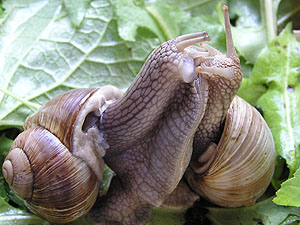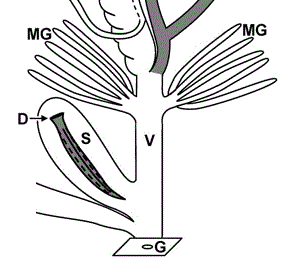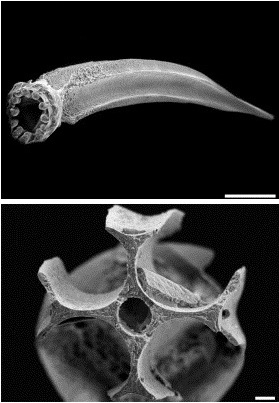
In spring, when the Roman snail awakes from hibernation, it's
mating season begins. [RN]
The love dart (gypsobelum) is produced in some terrestrial snail groups' genital apparatus, to fulfil an important role during the process of mating. Love darts can be between 1 and 30 mm in length and are made of calcium carbonate, chitin or cartilage. Their fine construction also makes it possible to tell apart even closely related snail groups.
The best known love darts are among the helicid snails (Helicidae), among those edible snails and banded snails, and related groups. Especially among the common Roman snail (Helix pomatia) and the brown garden snail (Cornu aspersum) love darts and the role they play during mating, are best known.
The Canadian scientist Dr. Ronald Chase assumes that the ancient legend of Cupid's (or Eros in the Greek mythology) love darts can be retraced to observations of snails' mating plays.
 In spring, when the Roman snail awakes from hibernation, it's mating season begins. [RN] |
Terrestrial pulmonate snails (Stylommatophora) generally are hermaphrodites, they possess a highly developed genital apparatus with female, male and hermaphroditic organs. In this system, the love dart is produced in a special organ, the dart sac (bursa telae).
While the helicid snails love dart is made from calcium carbonate (CaCO3), in other terrestrial snail groups there are love darts made from chitin or cartilage.
The mating procedure of the Roman snail may often last for several hours and is researched best. During this mating play the love dart may be applied, stung into the mating partner's foot. For this to happen, the dart sac is turned outside of the genital pore, during which movement the love dart is pushed out sitting on a papilla in the dart sac. Though it is called a love dart in English and Liebespfeil (love arrow) in German, the love dart does not fly freely, it is pushed like a lance.
 This brown garden snail (Cornu aspersum) has been hit by no less than two love darts. The frontal one, however may origi- nate from a grove snail (Cepaea nemoralis) [RN] |
After the love dart has been applied, mating is continued with growing intensity, until after some trials actual copulation takes place, during which a spermatophore containing sperm cells is exchanged mutually by both partners. In the ideal case the love dart is stung into the partner's foot, it may, however, also happen that a snail is stung by several darts at once, or that a love dart does not penetrate at all and falls away without result. There may even be injuries, when, for example, the love dart is stung into a snail's head in a way, that the snail is unable to extend one tentacle.
Snails always produce on love dart per dart sac, when that has been applied, the snail may need some time to produce another one. In this time further matings may happen, not necessarily including application of a love dart. Obviously the mating is basically necessary to induce production of the first love dart in the genital apparatus (Chung 1986), so during the first matings of a snail, no love dart is applied.
While several snail species only possess one dart sac, there are others who do possess several. Among those there are the bush snails (Bradybaenidae) and the leaf snails (Hygromiidae), as well as the family Helminthoglyptidae from the South and Southwest of North America.
The role of the love dart during the mating of snails for a long time has been unknown. That the love dart is connected to copulation is already in the expression love dart as such, pointing towards the love arrow of Cupid or Eros from Roman or Greek mythology.
Originally it was assumed that the love dart had mainly a sexually stimulating role among snails. According to another hypothesis, the love dart is a gift of calcium to the receiving snail. That would at least help in the production of egg shells. Calcium carbonate, besides, is an important resource for snails, that must be taken in from nature.
Research results from since the eighties point into the direction of a completely other role of the love dart:
In the Roman snail's genital apparatus there is a specialized organ called a bursa copulatrix. It does not serve to collect sperm cells, as the obsolete term "Receptaculum seminis" would suggest. Instead it is used to digest sperm cells. This mechanism of selection serves to leave exclusively the most active and healthiest sperm cells for later fertilisation.
Of course it is in the best interest of the snail spending the sperm cells, to bring as many own sperm cells to fertilisation, as possible, as they will be collected together with their competitors from other matings, to be used for fertilisation only later.
 Schematic cut-out of a brown garden snail's (Cornu aspersum) genital apparatus. MG: Mucous glands; S: Dart sac; D: Love dart; V: Vagina; G: Genital atrium. Source: Koene, Schulenburg (2005). |
The love dart transmits a secretion produced by the mucous glands in the genital apparatus and containing a mix of hormones. Those hormones influence the spermoviduct of the receiving snail, the peristaltic movement of which now supports the sperm cells' way up the canal, which have to pass the spermoviduct to reach the sperm pouch at it's end, to be stored until fertilisation. This way, a larger part of the sperm cells survive, and thus the chance to inherit the spender snail's own genes is improved. By application of a love dart, the fertilisation chances of a snail can be doubled (Chase, R.; Blanchard, K. C.; 2006).
"The love dart is a tool of male manipulation" (National Geographic, 2002). The Canadian scientist Dr. Ronald Chase has found out that snails do avoid the partner's love dart. He describes the mating play of brown garden snails (Cornu aspersum) sometimes to look like a medieval knights' tournament ("jousting"), both snails circling each other to avoid being hit. Recent scientific discoveries in tree snails (Arianta arbustorum) have also revealed that the recipient of sperm cells probably has the possibility of selectively choosing sperm cells of one mating partner.
![]() The Roman snail's
genital apparatus: Explanation of the
participating organs.
The Roman snail's
genital apparatus: Explanation of the
participating organs.
 Common hair snail (Trochulus hispidus). Picture: Michal Maňas (Source). |
The love dart is only known from the terrestrial pulmonate snails (Stylommatophora) and some further, more ancient groups called the Systellomatophora. This allows the conclusion that the love dart is a primordial character of pulmonate gastropods (Pulmonata) reduced during the evolution of many terrestrial pulmonate groups. Rudimentary love darts are present in the Sagdidae family, reduced (degenerated) organs appear in many helicid relatives (Helicoidea). Thus the sarcobelum has been recognized as a reduced organ, which in an earlier state of evolution served to produce a love dart.
It is only among the bush snails (Bradybaenidae) and among the Dyakiidae family from Southeast Asia, that all species of the family are equipped with a love dart. Among all other groups the love dart has at least partially been reduced.
The Gastrodontidae, a family of gloss snails most common in North America, finally have developed a so-called "love dagger", a pointed calcareous stimulation organ adjacent to the penis, which is thus located in the male, not the female part of the genital apparatus.
As already mentioned in the beginning, love darts appear in numerous different groups of terrestrial pulmonates (Stylommatophora) and of the Systellommatophora. They are species specific to a high grade and may be differentiated from their construction and thus also linked to different species. The blunt end of a love dart usually ends in a so-called crown which sits on the dart sac papilla.
While the common hair snail's (Trochulus hispidus) love dart resembles to a simple rounded dagger blade, the banded garden snail's (Cepaea hortensis from the subfamily of Helicinae) love dart is improved by several lateral blades running from tip to end. In contrary to that among the Ariantinae, love darts only sometimes possess lateral blades.
While helicid snails' love darts usually are more or less straight, there also sabre-like curved love darts in other groups or even spirally wound darts like in the incarnate snail (Monachoides incarnatus).
A love dart's size may be very different as well, ranging between 1 mm in the smallest snails species to about 30 mm in larger species. In the semi-slug genus Parmarion (Helicarionidae) the love dart may take as much as one fifth of the overall body length.
 Electron microscope picture of a banded garden snail's Cepaea hortensis (Helicidae) love dart. Source: Koene, Schulenburg (2005). |
 |
|
| Perforatella incarnata (Hygromiidae) | |
 |
|
| Arianta arbustorum (Helicidae, Ariantinae) | |
 |
|
| Cepaea hortensis (Helicidae, Helicinae) | |
 |
|
| Cepaea nemoralis (Helicidae, Helicinae) | |
 |
|
| Helix pomatia (Helicidae, Helicinae) | |
 |
|
| Helix lucorum (Helicidae, Helicinae) | |
 |
|
| Cornu aspersum (Helicidae, Helicinae) | |
| Love darts in comparison. Source: Koene, Schulenburg (2005). |
In the subsequent snail groups love darts have been found:
(The list is not complete)
Systellommatophora
Onchidioidea
Onchidiidae
Stylommatophora
Helicoidea
Helicidae
Bradybaenidae
Helminthoglyptidae
Hygromiidae
Humboldtianidae
Zonitoidea
Zonitidae
Gastrodontidae
Arionoidea
Philomycidae
Helicarionoidea
Urocyclidae
Ariophantidae
Helicarionidae
Limacoidea
Vitrinidae
Dyakioidea
Dyakiidae
Parmacelloidea
Parmacellidae
Chase, R.; Blanchard, K.C. (2006): The snail's love-dart delivers mucus to increase paternity. Proc Biol Sci. 2006 Jun 22;273(1593):1471-5. (Abstract).